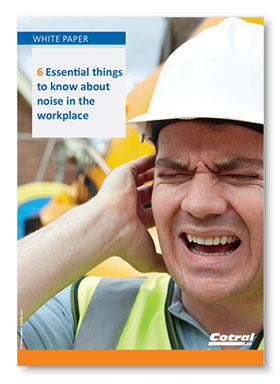Assumed to be economical, hygienic and effective, the disposable cap is perceived as the all-purpose solution against noise. What is it really like?
To preserve the hearing health of your staff, it is important to protect them from noise levels higher than 80 dB(A). Hearing protection devices should be suitable and effective.
A hearing protection device is effective only when it is worn 100% of the time spent in a noisy
environment!
Not wearing it for 10 minutes at 80 db(A) reduces its efficiency by 40%!
Hearing protection devices act like an umbrella: When it is open, it protects you from rain. However, if you do not
use it for 10 minutes while it rains, you are going to get wet! Even if you open it afterwards, you will remain
wet!
If you remove your hearing protection for a few minutes in high intensity noise, the level of noise
received will damage your ears, leading to tinnitus and, eventually, hearing loss.
Are disposable ear plugs an effective solution? Not really.
Even if disposable ear plugs are easy to distribute among employees exposed to noise, it is common knowledge that they are far from effective:
- They are uncomfortable and poorly adapted
- They can irritate the ear canal or the ears
- They make it difficult to communicate in a noisy environment

Furthermore, their efficiency has been questioned through various studies conducted by manufacturers. These studies reveal that those types of hearing protection devices do not fit well in the ears.
Wearing disposable ear plugs is more complicated than it looks! They can be improperly inserted and/or not sufficiently rolled to enable expansion and optimal fit into the ear canal. If not adapted to the size of the ear canal, they might fall off of the user's ears.
If improperly inserted, disposable ear plugs, which are meant to reduce noise by 30 dB(A), will only provide a 10 dB(A) attenuation! How will users know if their disposable ear plugs are correctly inserted? How many of them correctly wear their traditional hearing protection devices when exposed to noise?

Are disposable ear plugs a profitable investment? Not really.
Why are 3MTM or HoneywellTM standard hearing protection devices preferred?
- Easy to deploy in workshops: using dispensers so that employees can access them anytime
- Standards: disposable or reusable ear plugs and ear muffs are supposed to fit everybody equally
- Low unit cost
As a result: Disposable earplugs appear to fulfill the need to protect employees by providing a cost-effective solution at first glance.
Such savings can be deceptive, since users wear their devices improperly or do not wear them at all!
Manufacturers recommend using 1 to 2 pairs per day, per employee, or even more, depending on the kind of usage. With 2 pairs per day, 440 disposable ear plugs will be used per year, per employee (2 earplugs x 220 days)!
This makes more than 2 boxes per employee! On the basis of 13 cents, the cost is €66 per employee each year.
| People exposed to noise | Theoretical annual budget (Disposable ear plugs) |
|---|---|
| 1 | €66 / £58 |
| 50 | €3,300 / £2,922 |
| 100 | €6,600 / £5,845 |
| 300 | €19,800 / £17,537 |
| 600 | €39,600 / £35,074 |
Is your budget lower than what it should be? Perhaps your employees do not wear their hearing protection devices as often as they should, or the way they should be worn.
As a result: Your employees might suffer from tinnitus and eventually hearing loss (a few at age 40, and many by age 50), with the constant risk of permanent hearing loss. As for your organization, the cost for a confirmed case of occuptional noise-induced hearing loss is €100,000 / £88,574 on average.
If disposable ear plugs are not worn 100% of the time spent in noise, they will not be effective. Would you purchase safety gloves that would not protect your employees' hands? Ask yourself the same question regarding their hearing protection.
In order to have effective hearing protection devices that can be worn 100% of the time when exposed to noise, users would prefer wearing custom moulded ear plugs over disposable ear plugs for the following reasons:
- They are comfortable enough to be worn all day
- They allow for communication and situational awareness, even in noisy environments
- They are easy to wear, clean and maintain


